—— Guide ——
This is a report on the definition, features, classification, and market development status of IoT platforms, suitable for IoT developers, any IoT solution or hardware and software providers, IoT users, enterprise IoT procurement personnel and decision-makers, and anyone interested in learning about IoT.
An IoT platform is a type of middleware, positioned between the IoT device layer and the IoT gateway (and data) layer on one side, and between applications on the other side. Therefore, IoT platforms are also called Application Enablement Platforms (AEPs).
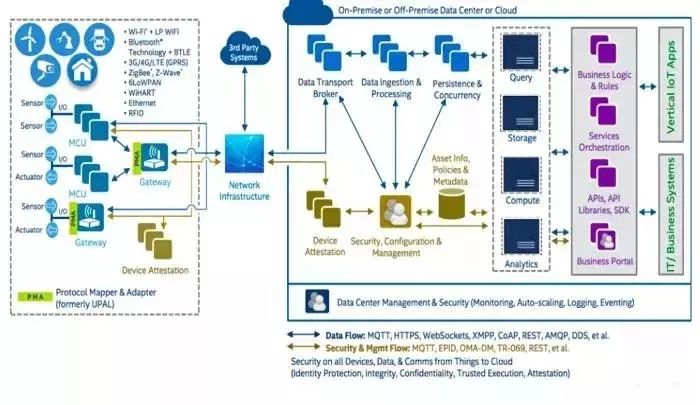
IoT platforms support IoT device and endpoint management, connection and network management, data management, processing and analysis, application development, security, access control, monitoring, event handling, and interface/integration.
We will overview all the basic functions of IoT platforms and the evolution of the IoT platform market and selection criteria that you should understand as a potential buyer before choosing the right IoT platform for you.
IoT platforms have become an important component of IoT deployments, and there are several types of platforms and vendors that focus on different aspects and market strategies. Additionally, the reality and market of IoT platforms are very complex, as IoT projects, applications, and solutions have different architectures, methods of connecting and managing devices, possibilities for managing and analyzing data, capabilities for building applications, and options for leveraging the IoT value in any given environment. For example, consumer applications, enterprise IoT applications, and industrial IoT or Industry 4.0.
Artificial intelligence and machine learning are often crucial for advanced data analysis. The analysis, processing, and transmission of certain types of data may be critical, or rapid responses occurring at the edge (the location of the devices/assets and specific gateways) require the use of edge computing and fog computing, along with edge platforms.
Another example: in smart city cases, preferred open-source platforms often appear, requiring low-power wide-area networks or communication methods. In manufacturing, some companies may use digital twins to name. In fact, this has impacted industrial IoT platforms and manufacturing platforms.
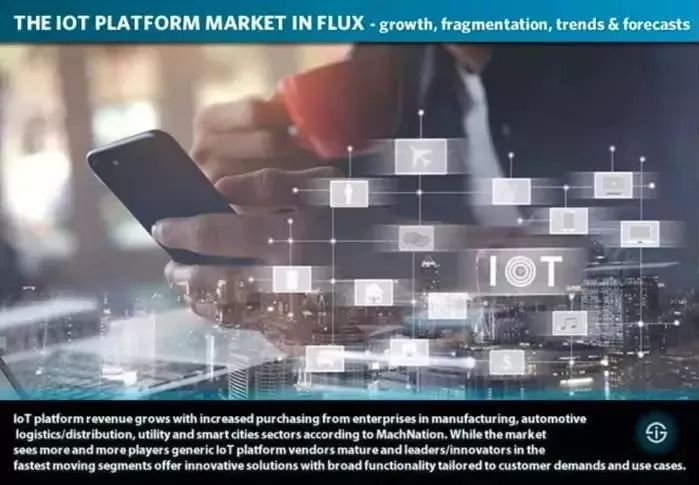
What types of IoT platforms are there?
How do they help IoT projects?
Features of IoT platforms: various styles, similar functions, different advantages.
In addition to the aforementioned types of IoT platforms, there are large general-purpose IoT cloud platforms from vendors like Microsoft, Google, Amazon, and IBM. Another category of IoT platforms is the so-called IoT network provider platforms, with vendors including AT&T, Orange Business Services, Telefónica, Verizon, and Vodafone. Additionally, there are IoT business platforms, typically used for vertical applications and markets such as building management, specific smart industrial areas, utilities and energy, oil and gas, logistics and transportation, and the overall resource industry.
Enterprises should evaluate the required AEP based on four aspects: development requirements; flexibility and scalability; operational complexity; and a well-executed partnership strategy and platform ecosystem.
As mentioned above, all these IoT platforms have the same types of functions, with certain IoT platforms excelling in specific areas compared to others. This is also one of the complexities of the IoT platform market, as evidenced by the diverse reasons behind the platform origins and backgrounds of the several vendors mentioned so far. It is clear that platforms from network operators are typically stronger in communication and network capacity, while platforms designed specifically for application support provide more robust capabilities at that level, and device manufacturers’ platforms are stronger in device management, etc. Therefore, it is crucial to choose an IoT platform wisely.
Definition and Basic Functions/Advantages of IoT Platforms
IoT platforms have their roots in the need to manage, monitor, store, parse, protect, and analyze IoT data; enable applications; manage IoT devices; ensure connectivity and integration due to the lack of standards and interoperability in IoT; provide security, firmware updates, and subscriber and access management; and facilitate visualization and application interfaces for users and developers.
IoT platforms enable faster, cheaper, and better construction of IoT solutions, facilitating IoT projects. Their basic features include connection and network management, device management, data collection, processing analysis and visualization, application support, integration, and storage.
With the emergence of more IoT devices/assets, data, related technologies, network/connection solutions, and infrastructure development, as well as efficient, interoperable, and secure ways to connect, IoT platforms have become specialized for IoT deployments.
In IDC’s evaluation of IoT device management and network connection platforms, the definition of IoT platforms from the research firm is as follows: “A commercial software product that provides a combination of the following functions: management of IoT endpoints and connections; access, ingestion, and processing of IoT data; visualization and analysis of IoT data; and tools for IoT application development and integration.”
Selecting an IoT Platform: Business Relevance and Functional Criteria
When selecting an IoT platform, performance is certainly key. MachNation categorizes the metrics used for testing and ranking into several subcategories that represent the performance and evaluation criteria of IoT platforms, which are naturally not only based on performance but also on business standards.
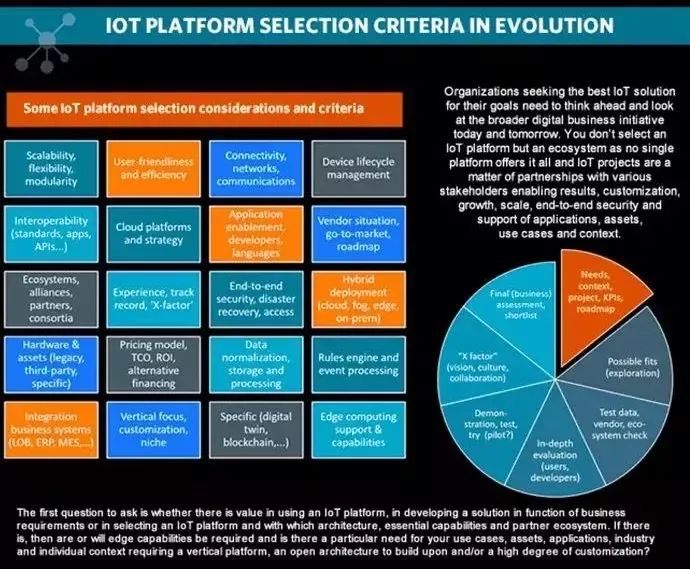

Among the many criteria for choosing the best IoT platform for your enterprise, consider the following questions:
• What is the performance record of the IoT platform vendor? Has the vendor adapted to the changing market and technology? What projects has the platform deployed, and what were the results? What is the vendor’s roadmap, and does it align with yours?
• How are the vendor’s alliances, channel partners, and overall ecosystem? Is it part of a stable ecosystem? Does it have a good ecosystem itself? Does its go-to-market strategy (do you need channel partners, niche experts, system integrators, etc.) meet your needs? Does it provide a vertical approach or ecosystem for your specific business/industry?
• How user-friendly and effective is the IoT platform in executing/enabling basic tasks? How long does it take to onboard new IoT devices? Is it “zero-touch” or does it require specialized “onboarding training,” and how long does that take? Is it suitable for third-party zero-touch (and secure) device onboarding/configuration/management systems? How much time do users need to perform other tasks? Is the interface and functionality user-friendly across various communication protocols, visualizations, and decision-making within the range of supported applications?
• Is it an open, interoperable, and developer-friendly platform? What cloud platform is used? What programming languages? How easy is application enablement? Is there pre-packaged data and application functionality? How well does it connect with the business applications and other IoT applications you need and want? Does it support appropriate standards, devices, communication technologies, etc.?
• How scalable is the platform? Again: you are not just choosing an IoT platform here. When your IoT deployment is complete, there may be new opportunities, possibilities, and innovations that require your IoT platform to support more IoT devices than the initial project. This impacts many aspects, including the mentioned onboarding, security, bandwidth, latency, performance, and even more protocols, as well as interoperability with other solutions and service providers.
• How is security handled? While we will consider security within the edge capabilities below, it certainly needs to be mentioned among the many standards for choosing IoT platforms. It’s not just about authentication, authorization, and encryption, but also not solely about the entire IoT stack, such as IoT devices or communication protocols and networks. While edge capabilities are often seen as enhancing security for various reasons, IoT projects and deployments need to be designed with end-to-end security, influenced by legislation such as the General Data Protection Regulation and the Electronic Privacy Regulation globally, as they pertain to the privacy of personal data.
This list of IoT platform selection criteria is far from complete. There are also pricing models (and potential hidden costs, especially in certain types of platforms like mobile network operator platforms, which can also include mobile connectivity data plan costs).
MachNation’s IoT platform capabilities across devices, edge, and cloud are divided into 8 categories.


IoT Platform Market:
Opportunities, Challenges, Winners, and Dynamics
Let’s take a look at the IoT platform market. There are now hundreds of players in this field, some of whom claim to be IoT platform vendors. IoT platforms represent €15 billion of the €250 billion allocated for IoT in 2020.
As mentioned above, while true IoT platforms share many common functions (core features), there are many differences among various products, and sometimes many different functions. No two IoT platforms are the same.
Here are examples of well-known companies and solutions (at least vendors): Amazon (AWS IoT), AT&T (AT&T IoT Platform), Bosch (Bosch IoT Suite), Ericsson (Application Platform for IoT), Gemalto (SensorLogic), HPE (HPE Universal IoT Platform), IBM (Watson IoT Platform), Microsoft (Azure: Stream Analytics, IoT Hub, IoT Suite), PTC (ThingWorx Technology Platform), SAP (SAP HANA Cloud Platform for the Internet of Things), relayr and Software AG (Cumulocity IoT).
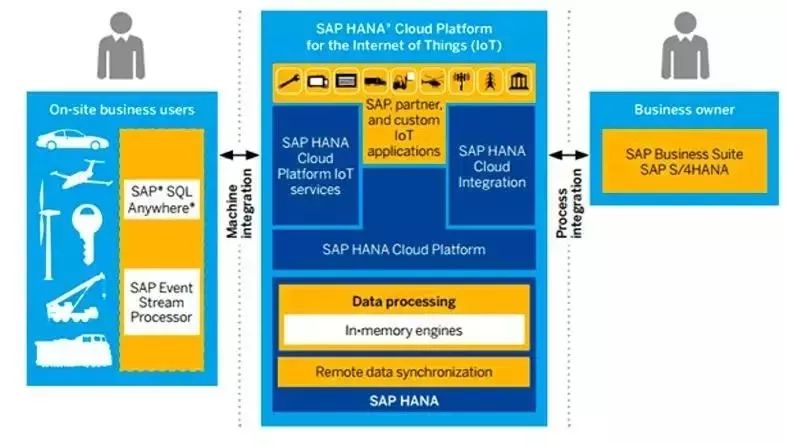
SAP HANA Cloud Platform for the Internet of Things
Challenges Facing the IoT Platform Market
A major issue in the IoT platform market is the oversaturation; the market is still expanding, and undoubtedly some players will either become very vertical or exit sooner or later.
This is somewhat reminiscent of the old internet era adage: grow big, get niche, or get out. Growing bigger can be achieved through several means: large partnerships, big investors, and most importantly, delivering significant benefits to customers at any level (vendors need to be customer-centric, creative, and focused on business rather than hype).
In recent years, the number of new entrants has continued to increase dramatically. In the summer of 2017, IoT Analytics announced through its database tracking the market that there were 450 IoT platform vendors, or at least vendors claiming to have IoT platforms. For comparison: in 2015, the company estimated there were 260 IoT platforms, and in 2016, its database included 360 IoT platforms.
The IoT platform market continues to become more crowded and fragmented. However, dynamics are changing: while we continue to witness a steady influx of new startups into this field, most large vendors seem to have placed their bets – opportunities for multinationals entering are becoming fewer.
In the types of IoT platforms, IoT analysts build their lists around the following parameters:
• Application enablement
• Device management
• Analytics
• Cloud storage
• Backend connectivity
This aligns more or less with how IDC defines IoT platforms and MachNation’s view, which is a combination of interoperable, ideally modular, and open capabilities.
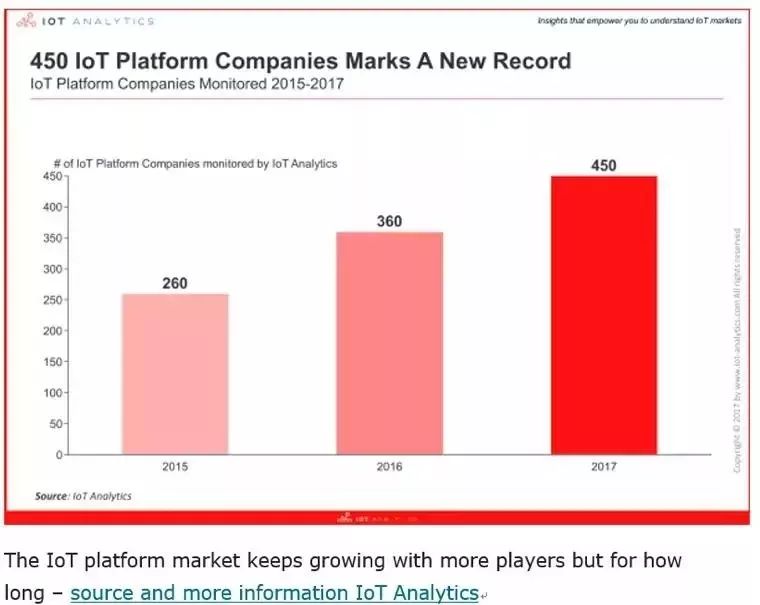
Growth and Spending in the IoT Platform Market
MachNation is one of the many companies researching the IoT platform market using annual ScoreCards. According to MachNation, total revenue for IoT platforms will reach $3.3 billion in 2018, an increase of 89% from 2017.
In 2018, IoT platform revenue is expected to reach $3.3 billion, with significant increases in enterprise purchases from sectors such as manufacturing, automotive, logistics/distribution, utilities, and smart cities, according to MachNation, as companies seek to establish a competitive advantage in the market. IoT platforms can reduce development time and costs.
In the previous version of the report, MachNation projected that IoT platform revenue would reach $2 billion in 2017, reflecting a 116% increase compared to 2016. In this version, MachNation also projected that global revenue for IoT application support and device management would reach $83.4 billion by 2025. From the updated charts for 2018, growth appears to be slower than previously expected, and IDC has adjusted its investment forecasts for IoT in 2018.

Dynamics of IoT Platform Vendors and Solutions
Everyone agrees on one thing: the market is fragmented, complex, overcrowded, and chaotic as more and more players chase the same slice of pie.
This chaos means that the IoT platform market remains relatively immature and overcrowded, which may be one reason for its somewhat slow growth. Additionally, more vendors mean more competition, leading to more participants pursuing corporate deployments of IoT projects.
This certainly does not mean that new players have no room and that the game is over; quite the opposite. Some new vendors are adopting an entirely different approach, often focusing on specific verticals or several areas where the capabilities needed for IoT deployment have only emerged in recent years and are becoming increasingly important.
IIoT platform vendors need to deepen and expand their platform capabilities to support and integrate emerging transformative technologies such as augmented reality and artificial intelligence. Typical examples include the aforementioned edge intelligence, mobile, artificial intelligence, and machine learning (depending on the use case and industry).
Clearly, not only are new vendors focusing on niche and/or specific use cases and/or supporting more technologies and applications. Established vendors have also made significant strides in the same direction. Many of them are evidently paying attention to the preferences and needs of buyers at all levels.
To gain deeper insights into these evolutions, it is important to distinguish between various IoT platforms and industry focuses. As IoT analysts have recently confirmed, the most significant IoT platforms are primarily focused on manufacturing and industrial sectors, followed by smart cities.
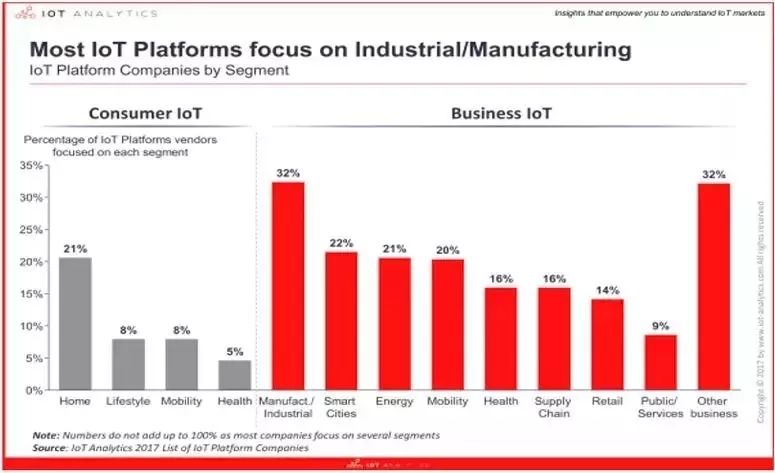
As most platforms focus on the industrial sector, IIoT platforms lead the IoT platform market.
On a more general level, MachNation points out that enterprises are not building their platforms but are choosing to purchase cloud-based products from best-in-class IoT AEP vendors.
In previous versions of the IoT Application Enablement Platform (AEP) ScoreCard, the company found that service providers and enterprises were more interested in open-source IoT AEP technologies.
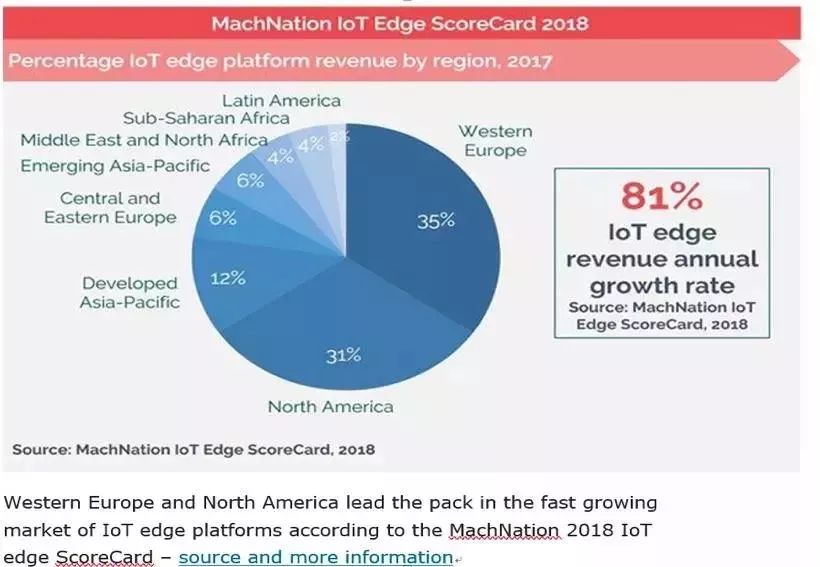
From the perspective of the overall IoT platform market, there has already been considerable consolidation, with some participants leaving the market (according to the aforementioned IoT Analytics update, more than 30 companies included in 2016 are no longer in existence), indicating either bankruptcy or acquisition, and many more players are expected to be forced out of the market.
As Gartner listed in its competitive landscape for IoT platform vendors (May 2017): “Although not very mature, the IoT platform market is highly competitive, with hundreds of companies offering solutions. To succeed, technology product marketing leaders need to strengthen their IoT market strategy and spread and educate their ‘art’ and technology in the market.

AWS IoT Platform
A Few Words About IoT Application Enablement Platforms
According to IOT Analytics, 92% of IoT platforms primarily focus on application enablement, which is also at the core of MachNation’s predictions and methodologies, distinguishing between two types of IoT application enablement solutions and vendors.
• IoT Application Enablement Platforms (AEP)
AEP vendors have technology-centric products aimed at providing the best, broadly applicable core middleware for customers to build interconnected or independent IoT solutions, according to MachNation. AEP vendors rely on flexible deployment models; a comprehensive set of device and enterprise backend connectors, SDKs, and APIs; and a well-documented set of developer resources.
• Platform-Enabled Solutions (PES)
PES is not technology-centric but solution-centric. MachNation states that it is optimized to shorten the time for customers to provide fully enabled end-to-end vertical IoT solutions.
The IoT software platform market has undergone significant changes in recent years, but it remains a complex and fragmented space. IDC believes it is essential to define a common IoT platform architecture to correctly classify and size this crowded market. (Stacy Crook, IDC)
As we approach the 2018 manufacturing IIoT platform report, ABI Research also focuses on AEP and delves into the application enablement platform approach. “AEP provides solutions for importing data, but they often require partners to provide gateways. Some AEPs offer ‘one-stop services’ that can obtain data from at least some devices and may work like an operating system with an app store. If they open application development, they can use applications built by AEP vendors and from partner applications (potentially also calling themselves platforms), end users, or independent developers, similar to smartphone app stores. Some ‘one-stop services’ focus more on data extraction and transferring it to the cloud, while others are more concerned with passing data to enterprise systems or operating systems. Other IIoT platforms focus on specific application enablement or microservices, such as fog computing or processing raw sensor data.”
Author BIO: Zhi-Hong Zeng (1638881963wechat): Freelance, graduated from Beijing University of Science and Technology, MBA from National University of Singapore, previously served at GE, Rolls-Royce, JCI, Whirlpool, a promoter of new technologies and applications, a writer for online media, focusing on and researching IoT, green logistics, Industry 4.0, artificial intelligence, blockchain, smart cities, etc.
Source: Imagination Tech